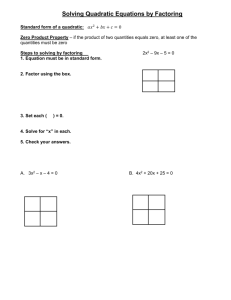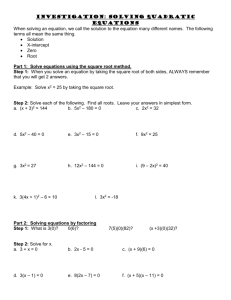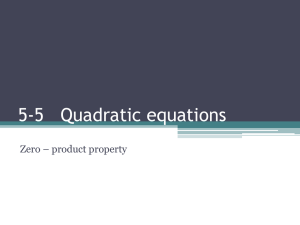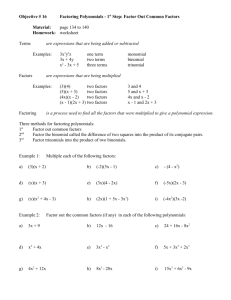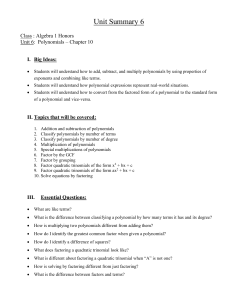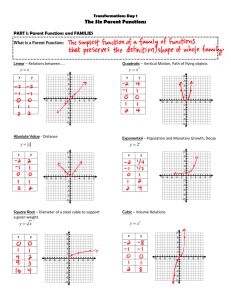“JUST THE MATHS” UNIT NUMBER 1.8 ALGEBRA 8 (Polynomials
advertisement
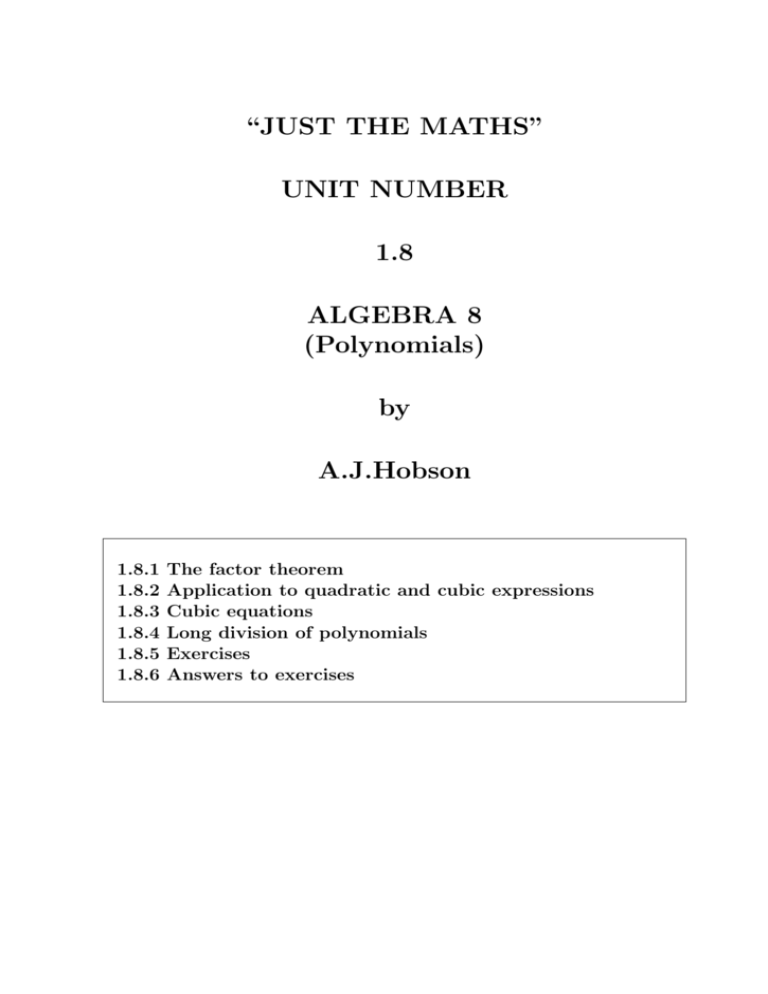
“JUST THE MATHS” UNIT NUMBER 1.8 ALGEBRA 8 (Polynomials) by A.J.Hobson 1.8.1 1.8.2 1.8.3 1.8.4 1.8.5 1.8.6 The factor theorem Application to quadratic and cubic expressions Cubic equations Long division of polynomials Exercises Answers to exercises UNIT 1.8 - ALGEBRA 8 - POLYNOMIALS Introduction The work already covered in earlier units has frequently been concerned with mathematical expressions involving constant quantities together positive integer powers of a variable quantity (usually x). The general form of such expressions is a0 + a1 x + a2 x2 + a3 x3 + ...... + an xn which is called a “polynomial of degree n in x”, having “coefficients” a0 , a1 , a2 , a3 , ......an , usually constant. Note: Polynomials of degree 1, 2 and 3 are called respectively “linear”, “quadratic” and “cubic” polynomials. 1.8.1 THE FACTOR THEOREM If P (x) denotes an algebraic polynomial which has the value zero when x = α, then x − α is a factor of the polynomial and P (x) ≡ (x − α)× another polynomial, Q(x), of one degree lower. Notes: (i) The statement of this Theorem includes some functional notation (i.e. P (x), Q(x)) which will be discussed fully as an introduction to the subject of Calculus in Unit 10.1. (ii) x = α is called a “root” of the polynomial. 1.8.2 APPLICATION TO QUADRATIC AND CUBIC EXPRESSIONS (a) Quadratic Expressions Suppose we are given a quadratic expression where we suspect that at least one of the values of x making it zero is a whole number. We may systematically try x = 0, 1, −1, 2, −2, 3, −3, 4, −4, ...... until such a value of x (say x = α) is located. Then one of the factors of the quadratic expression is x − α enabling us to determine the other factor(s) easily. 1 EXAMPLES 1. By trial and error, the quadratic expression x2 + 2x − 3 has the value zero when x = 1; hence, x − 1 is a factor. By further trial and error, the complete factorisation is (x − 1)(x + 3). 2. By trial and error, the quadratic expression 3x2 + 20x − 7 has the value zero when x = −7; hence, (x + 7) is a factor. By further trial and error, the complete factorisation is (x + 7)(3x − 1). (b) Cubic Expressions The method just used for the factorisation of quadratic expressions may also be used for polynomials having powers of x higher than two. In particular, it may be used for cubic expressions whose standard form is ax3 + bx2 + cx + d, where a, b, c and d are constants. EXAMPLES 1. Factorise the cubic expression x3 + 3x2 − x − 3 assuming that there is at least one whole number value of x for which the expression has the value zero. Solution By trial and error, the cubic expression has the value zero when x = 1. Hence, by the Factor Theorem, (x − 1) is a factor. Thus, x3 + 3x2 − x − 3 ≡ (x − 1)Q(x) 2 where Q(x) is some quadratic expression to be found and, if possible, factorised further. In other words, x3 + 3x2 − x − 3 ≡ (x − 1)(px2 + qx + r) for some constants p, q and r. Usually, it is fairly easy to determine Q(x) using trial and error by comparing, initially, the highest and lowest powers of x on both sides of the above identity; then comparing any intermediate powers as necessary. We obtain x3 + 3x2 − x − 3 ≡ (x − 1)(x2 + 4x + 3). In this example, the quadratic expression does factorise even further giving x3 + 3x2 − x − 3 ≡ (x − 1)(x + 1)(x + 3). 2. Factorise the cubic expression x3 + 4x2 + 4x + 1. Solution By trial and error, we discover that the cubic expression has value zero when x = −1, and so x + 1 must be a factor. Hence, x3 + 4x2 + 4x + 1 ≡ (x + 1)Q(x), where Q(x) is a quadratic expression to be found. In other words, x3 + 4x2 + 4x + 1 ≡ (x + 1)(px2 + qx + r) for some constants p, q and r. Comparing the relevant coefficients, we obtain x3 + 4x2 + 4x + 1 ≡ (x + 1)(x2 + 3x + 1) but, this time, the quadratic part of the answer will not conveniently factorise further. 1.8.3 CUBIC EQUATIONS There is no convenient general method of solving a cubic equation; hence, the discussion here will be limited to those equations where at least one of the solutions is known to be a fairly small whole number, that solution being obtainable by trial and error. We illustrate with examples. 3 EXAMPLES 1. Solve the cubic equation x3 + 3x2 − x − 3 = 0. Solution By trial and error, one solution is x = 1 and so (x − 1) must be a factor of the left hand side. In fact, we obtain the new form of the equation as (x − 1)(x2 + 4x + 3) = 0. That is, (x − 1)(x + 1)(x + 3) = 0. Hence, the solutions are x = 1, x = −1 and x = −3. 2. Solve the cubic equation 2x3 − 7x2 + 5x + 54 = 0. Solution By trial and error, one solution is x = −2 and so (x + 2) must be a factor of the left hand side. In fact we obtain the new form of the equation as (x + 2)(2x2 − 11x + 27) = 0. The quadratic factor will not conveniently factorise, but we can use the quadratic formula to determine the values of x, if any, which make it equal to zero.They are √ 11 ± 121 − 216 x= . 4 The discriminant here is negative so that the only (real) solution to the cubic equation is x = −2. 1.8.4 LONG DIVISION OF POLYNOMIALS (a) Exact Division Having used the Factor Theorem to find a linear factor of a polynomial expression, there will always be a remaining factor, Q(x), which is some other polynomial whose degree is one lower than that of the original; but the determination of Q(x) by trial and error is not the only method of doing so. An alternative method is to use the technique known as “long division of polynomials”; and the working is illustrated by the following examples: 4 EXAMPLES 1. Factorise the cubic expression x3 + 3x2 − x − 3. Solution By trial and error, the cubic expression has the value zero when x = 1 so that (x − 1) is a factor. Dividing the given cubic expression (called the “dividend”) by (x − 1) (called the “divisor”), we have the following scheme: x2 + 4x + 3 + 3x2 − x − 3 x− x3 − x2 4x2 − x − 3 4x2 − 4x 3x − 3 3x − 3 0 1)x3 Note: At each stage, using positive powers of x or constants only, we examine what the highest power of x in the divisor would have to be multiplied by in order to give the highest power of x in the dividend. The results are written in the top line as the “quotient” so that, on multiplying down, we can subtract to find each “remainder”. The process stops when, to continue would need negative powers of x; the final remainder will be zero when the divisor is a factor of the original expression. We conclude here that x3 + 3x2 − x − 3 ≡ (x − 1)(x2 + 4x + 3). Further factorisation leads to the complete result, x3 + 3x2 − x − 3 ≡ (x − 1)(x + 1)(x + 3). 2. Solve, completely, the cubic equation x3 + 4x2 + 4x + 1 = 0. Solution By trial and error, one solution is x = −1 so that (x + 1) is a factor of the left hand side. 5 Dividing the left hand side of the equation by (x + 1), we have the following scheme: x2 + 3x + 1 x + 1)x3 + 4x2 + 4x + 1 x3 + x2 3x2 + 4x + 1 3x2 + 3x x+1 x+1 0 Hence, the equation becomes (x + 1)(x2 + 3x + 1) = 0, giving x = −1 and x = √ −3± 9−4 2 ' −0.382 or − 2.618 (b) Non-exact Division The technique for long division of polynomials may be used to divide any polynomial by another polynomial of lower or equal degree, even when this second polynomial is not a factor of the first. The chief difference in method is that the remainder will not be zero; but otherwise we proceed as before. EXAMPLES 1. Divide the polynomial 6x + 5 by the polynomial 3x − 1. Solution 2 3x − 1)6x + 5 6x − 2 7 Hence, 6x + 5 7 ≡2+ . 3x − 1 3x − 1 6 2. Divide 3x2 + 2x by x + 1. Solution 3x − 1 x + 1)3x2 + 2x 3x2 + 3x −x −x − 1 1 Hence, 3x2 + 2x 1 ≡ 3x − 1 + . x+1 x+1 3. Divide x4 + 2x3 − 2x2 + 4x − 1 by x2 + 2x − 3. Solution x2 +1 2 4 3 2 x + 2x − 3)x + 2x − 2x + 4x − 1 x4 + 2x3 − 3x2 x2 + 4x − 1 x2 + 2x − 3 2x + 2 Hence, x4 + 2x3 − 2x2 + 4x − 1 2x + 2 ≡ x2 + 1 + 2 . 2 x + 2x − 3 x + 2x − 3 1.8.5 EXERCISES 1. Use the Factor Theorem to factorise the following quadratic expressions: assuming that at least one root is an integer: (a) 2x2 + 7x + 3; (b) 1 − 2x − 3x2 . 2. Factorise the following cubic polynomials assuming that at least one root is an integer: (a) x3 + 2x2 − x − 2; (b) x3 − x2 − 4; (c) x3 − 4x2 + 4x − 3. 7 3. Solve completely the following cubic equations assuming that at least one solution is an integer: (a) x3 + 6x2 + 11x + 6 = 0; (b) x3 + 2x2 − 31x + 28 = 0. 4. (a) Divide 2x3 − 11x2 + 18x − 8 by x − 2; (b) Divide 3x3 + 12x2 + 13x + 4 by x + 1. 5. (a) Divide x2 − 2x + 1 by x2 + 3x − 2, expressing your answer in the form of a constant plus a ratio of two polynomials. (b) Divide x5 by x2 − 2x − 8, expressing your answer in the form of a polynomial plus a ratio of two other polynomials. 1.8.6 ANSWERS TO EXERCISES 1. (a) (2x + 1)(x + 3); (b) (x + 1)(1 − 3x). 2. (a) (x − 1)(x + 1)(x + 2); (b) (x − 2)(x2 + x + 2); (c) (x − 3)(x2 − x + 1). 3. (a) x = −1, x = −2, x = −3; (b) x = 1, x = 4, x = −7. 4. (a) 2x2 − 7x + 4; (b) 3x2 + 9x + 4. 5. (a) 1+ x2 3 − 5x ; + 3x − 2 (b) x3 + 2x2 + 12x + 40 + 8 176x + 320 . x2 − 2x − 8


